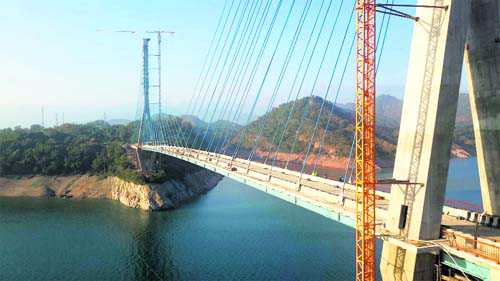A typical cable-stayed bridge is a continuous girder with one or more towers erected above piers in the middle of the span. From these towers, cables stretch down diagonally (usually to both sides) and support the girder. Steel cables are extremely strong but very flexible. Cables are very economical as they allow a slender and lighter structure which is still able to span great distances. Though only a few cables are strong enough to support the entire bridge, their flexibility makes them weak to a force we rarely consider: the wind.
For longer span cable-stayed bridges, careful studies must be made to guarantee the stability of the cables and the bridge in the wind. The lighter weight of the bridge, though a disadvantage in a heavy wind, is an advantage during an earthquake. However, should uneven settling of the foundations occur during an earthquake or over time, the cable-stayed bridge can suffer damage so care must be taken in planning the foundations. The modern yet simple appearance of the cable-stayed bridge makes it an attractive and distinct landmark.
The unique properties of cables and the structure as a whole make the design of the bridge a very complex task. For longer spans where winds and temperatures must be considered, the calculations are extremely complex and would be virtually impossible without the aid of computers and computer analysis. The fabrication of cable stay bridges is also relatively difficult. The cable routing and attachments for the girders and towers are complex structures requiring precision fabrication. There are no distinct classifications for cable-stayed bridges.
However, they can distinguish by the number of spans, number of towers, girder type, number of cables, etc. There are many variations in the number and type of towers, as well as the number and arrangement of cables. Typical towers used are single, double, portal or even A-shaped towers. Cable arrangements also vary greatly. Some typical varieties are mono, harp, fan, and star arrangements. In some cases, only the cables on one side of the tower are attached to the girder, the other side is anchored to a foundation or other counterweight.





